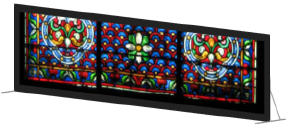 Inserting a Blended Screen
and Projector
Inserting a Blended Screen
and Projector Inserting a Blended Screen
and Projector
Inserting a Blended Screen
and ProjectorTool |
Tool set |
Blended Screen
|
Event Design |
The blended screen simulates projection screens that require multiple projectors to produce one large image.
The following modes are available:

Mode |
Description |
Modes for the Symbol Insertion tool |
See The Symbol Insertion Tool for parameter descriptions |
Preferences |
Sets the default properties for blended screen objects |
Place Screen |
Places and rotates the screen; the projectors can be added after placement |
Place Screen and Projector |
Places and rotates the screen and projectors |
Screen Trim Height |
Sets the Z value of the screen at insertion |

To insert a blended screen and projectors:
Click the tool and the desired symbol insertion and alignment modes.
Enter the Screen Trim Height value on the Tool bar.
Insert the object in the drawing.
● In Place Screen mode, click to place the screen, and click again to set the rotation.
● In Place Screen and Projector mode, click to place the screen, click again to set the screen rotation, and click again to place the projectors. This is especially useful when placing blended screens and projectors on hanging positions.
When projectors that are associated with a curved screen are placed on a hanging position, the projectors’ distance from the screen is determined by the hanging position geometry, not the curve of the screen.
The first time you use the tool in a file, a properties dialog box opens. Set the default properties.
When you use Place Screen mode to insert a blended screen, a Blended Screen object is created. Once the parameters of the blended screen and projectors have been set, click Insert Projectors from the Object Info palette to create the projectors associated with that screen. The blended screen settings control the initial projector settings, though each projector can then be set independently (by changing parameters like text position or cone display) if needed. Moving or rotating a blended screen after the projectors have been inserted also moves or rotates the associated projectors.
If projectors have already been inserted, clicking Insert Projectors deletes existing projectors and their parameter settings.
The height of the blended screen and associated projectors depends on several factors.
● The Z value determines the distance from the active layer plane to the bottom of the screen (including the border).
● When the screen includes legs, the legs are drawn on the active layer plane unless a Floor Height value has been specified. The Floor Height distance shifts the floor, and therefore the legs, by that amount from the layer plane.
● Projector stands are inserted relative to both the Vertical Shift and Floor Height values, allowing stands to be shifted up or down from the screen’s floor as set by the Floor Height value.
● When one of the blended screen components, either the screen or the projectors, is placed on a hanging position, that component assumes the height of the hanging position and is associated with it; the height of the other component is relative to the component on the hanging position. When the screen and projector components are each placed on a different hanging position, each component assumes the height of its hanging position and is associated with it. (See Inserting Hanging Positions.)
The blended screen and blended projector object parameters can be edited from the Object Info palette.
 Click
to show/hide the parameters.
Click
to show/hide the parameters.
 Click
to show/hide the parameters.
Click
to show/hide the parameters.
~~~~~~~~~~~~~~~~~~~~~~~~~